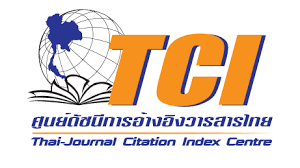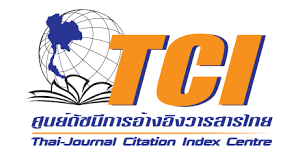Leadership and Organizational Innovation for Public Sector: A Systematic Review
Keywords:
leadership, innovation, public sector, systematic reviewAbstract
This systematic review aimed to analyze the characteristics and synthesize leadership influencing organizational innovation in public sectors. Research articles were searched from databases including Medline, Pubmed, CINAHL, Google scholar, and ThaiLIS. The inclusion criteria for paper selection included: 1) a research article mainly focused on leadership and innovation in public health organizations; 2) research article published in peer-reviewed journals with research quality criteria evaluation; and 3) a quantitative research article published between 2009 – 2018. The Quality Assessment Criteria for Research Papers7 was used as a tool to assess the selected research articles. The tool evaluated by the researcher team yielded 83.53% of inter-rater reliability. Kappa statistics was used to assess the consensus between the assessors. It was found that the research quality assessment between the assessors is not significantly different (k = 0.17, p = .13). Descriptive statistics were applied to describe research articles.
Findings are as follows: all research articles used quantitative design (n = 23). Mostly, the settings of study were governmental organizations which included multi organizations (n = 9), followed by educational sectors (n = 8), and health sectors (n = 6). Most studies were published during 2014-2018 (n = 19) and during 2009-2013 (n = 4). Most research studies were conducted for the purpose of predictive leadership and innovation in the organizations (n = 12), followed by the relationships between leadership and innovation (n = 10), and the least as descriptive study (n = 1). Most sample sizes range from 200 to 300 subjects (n = 8). The highest number of samples is 8,640 whereas the minimum is 83 subjects. In all studies, data were collected using a questionnaire (n = 23). The leadership concepts mostly applied in research studies was the Transformational Leadership Theory (Bass & Avolio, 1994) (n = 17). Leadership was used as an independent variable (n=22) and as a mediator (n = 1). The organizational innovation was mostly used as a dependent variable in studies (n = 21) and as a mediator (n = 2). The innovation mostly founded in the public sectors included process innovation (n = 10), product innovation (n = 7), service innovation (n = 4), and management innovation (n = 4). Therefore, the synthesized results of this research indicate that leadership-for-change style is an important factor and influencing innovations in public organizations.
Downloads
References
2. Denti L, Hemlin S. Leadership and innovation in organizations: A systematic review of factors that mediate or moderate the relationship. International Journal of Innovation Management 2012;16(3):1-20.
3. Dorsman SJ, Tummers LG, Thaen M. Understanding public sector innovations, The role of leadership activities for a climate for innovation. Public Administration 2015;1-21.
4. Cummings G, Lee H, Macgregor T, Wong C, Davey M, Paul L, et al. Factors contributing to nursing leadership: A systematic review. J Health Serv Res Policy 2008;13:240-8.
5. Beasu C, Benjinaru R. Leadership approaches regarding the organizational change. The USV Annals of Economics and Public Administration. 2013;13(18):146-52.
6. Moher M, Liberati A, Tetzlaff J, Altman DG, The PRISMA group preferred reporting items for systematic reviews and meta-analysis: The PRISMA statement. Journal of Clinical Epidemiology 2009;62:1006–12.
7. Kmet LM, Lee RC, Cook L S. Standard quality assessment criteria for evaluating primary research papers from a variety of fields. Canada: Interpret Design Inc; 2004.
8. Bass BM, Avolio BJ. Improving organizational effectiveness through transformational leadership. CA: SAGE. 1994.
9. Khan ZA, Nawazl A, Khan I. The impact of leadership style on innovation in health service, Gomal University Journal of Research 2015;31(1):143-54.
10. Tang H. Effects of leadership behavior on knowledge management and organization innovation in medicine and health sciences. EURASIA Journal of Mathematics Science and Technology Education 2917;13(8):5425-33.
11. Bagheri A, Akbari M. The impact of entrepreneurial leadership on nurses’ innovation behavior. Journal of Nursing Scholarship 2017;50(1):28–35.
12. Somech A. The effects of leadership style and team process on performance and innovation in functionally heterogeneous teams. Journal of Management 2009; 32(1):132-57.
13. Ricard MA. Innovation capacity in the public sector: What’s the link between leadership and innovation? research results from the LIPSE project on Innovation in the public sector funded by the 7th Framework Program of the European Union; 2014.
14. Ghanbari H, Eskandari A. Transformational leadership, job satisfaction, and organizational innovation. Journal of Management Perspective 2015;1(4):81-94.
15. Khan R, Rehman AU, Fatima A. Transformational leadership and organizational innovation: Moderated by organizational size. African Journal of Business Management 2009; 3(11):678-84.
16. Muchtar YC. The Influence of transformational leadership style on innovation mediated by organizational culture. Journal of Management Research 2014;6(4):176-86.
17. Tang H. Effects of leadership behavior on knowledge management and organization innovation in medicine and health sciences. EURASIA Journal of Mathematics Science and Technology Education 2017;13(8):5425-33.
18. Bagheri A. The impact of entrepreneurial leadership on nurses’ innovation behavior. Journal of Nursing Scholarship 2018;50(1):28–35.
19. Ali KAM, Buang M. Study on factors that influence innovation in Malaysian public sector. Journal of Advanced Research in Business and Management Studies 2016;4(1):60-73.
20. Dorsman SJ, Tummers LG,Thaens M. Understanding public sector innovations the role of leadership activities for a climate for innovation. Public Administration 2015;1-21.
21. Naguib HM, Naem AE. The impact of transformational leadership on the organization innovation. The International Journal of Social Sciences and Humanities Invention 2018; 5(1):4337-43.
22. Chen DX, Peng XB. Research on the relationship between transformational leadership and government service innovation. Open Journal of Leadership 2017;6:82-94.
23. Karimi F, Morshedi Z. The relationship between transformational leadership with organizational Innovation. Journal of Educational and Psychological Researches, 2015;1(3), 226-233.
24. Amri AY, Hassan R, Isaac O, Masoud Y. The effect of transformational leadership on organizational innovation in higher education: The case of developing countries. International Journal of Management and Human Science 2018;2(4):25-37.
25. Tang LL, Yeh YL. Effect of organizational culture, leadership style, and organizational learning on organizational innovation in the public sector. Journal of Quality 2015;22(5),461-480.
26. Zhang Dl. The effects of integrative leadership on the enterprise synergy innovation performance in a supply chain cooperative network. Sustainability 2017;10:1-20.
27. Zhang Y, Zheng J, Darko A. How does transformational leadership promote innovation in construction? the mediating role of innovation climate and the multilevel moderation role of project requirements. Sustainability, 2018; 10, 1-19.
28. Gomes C, Curral L, Caetano A. The mediating effect of work engagement on the relationship between self-leadership and individual innovation. International Journal of Innovation Management 2017;19(1):1-18.
29. Somech A. The effects of leadership style and team process on performance and innovation in functionally heterogeneous teams. Journal of Management 2009;32(1):132-57.
30. Aarons AG, Sommerfeld DH. Leadership, innovation climate, and attitudes toward evidence based practice during a statewide implementation. J Am Acad Child Adolesc Psychiatry 2012;51(4):1-15.
31. Mokekhaow K, Luangamornlert S, Chintanadilok N, Sritoomma N, The relationship model among transformational leadership, knowledge creation and innovation management performance in nursing units at community. Nursing Journal of the Ministry of Public Health 2017;27(3)163-75. (in Thai)
32. Abbasi B. Transformational leadership and change readiness and a moderating role of perceived bureaucratic structure: an empirical investigation. Problems and Perspectives in Management 2017;15(1):35-44.
Downloads
Published
How to Cite
Issue
Section
License
Article published Is the copyright of the Journal of Health and Nursing Research (Boromarajonani College of Nursing, Bangkok) Cannot be republished in other journals

















